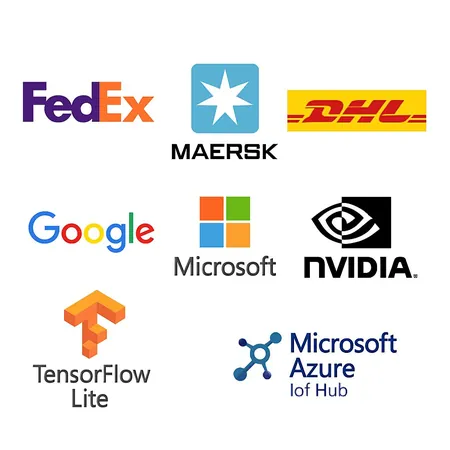
Revolutionizing Logistics: The Edge Computing Breakthrough You've Been Waiting For!
2025-04-28
Author: Siti
Why Edge Computing is the Future of Logistics
As logistics networks grow ever more intricate, the surge of real-time data from devices and facilities skyrockets. Traditional cloud systems, relying on centralized processing, can no longer keep pace with the speed and reliability required for efficient operations.
Enter edge computing! This groundbreaking approach processes data right at the source, slashing latency and enhancing resilience. But while the potential is immense, deploying edge computing in logistics isn't without its hurdles.
The Hurdles of Edge Computing in Logistics
First off, managing complex logistics with edge systems presents various challenges. Network inconsistencies, especially in remote locations like warehouses and ports, can result in minor yet impactful delays.
Bandwidth management is crucial; allocating resources effectively among numerous connected devices can be a daunting task as operations scale.
Then there’s the matter of device management. With a vast array of sensors, cameras, and vehicles, operators need to continuously provision, update, and monitor devices—each representing a potential failure point and security risk.
To make matters more complicated, edge device security is paramount. Unlike cloud infrastructures, edge devices are often physically reachable, rendering sensitive data—like shipment details and customer information—more vulnerable to breaches.
Moreover, the lack of industry-wide standards exacerbates the situation, with various manufacturers using different systems, adding to the headaches of integration.
On top of that, AI models designed for cloud environments don’t always translate well to smaller edge devices, requiring careful optimization of model size and efficiency.
Cost is another major consideration. Building a robust edge environment needs substantial initial investment, and showcasing a clear return on investment can be tricky.
Adverse environmental conditions also pose challenges, as edge devices must often withstand rugged elements, affecting their reliability.
Lastly, complex real-time decision-making must occur autonomously, with data synchronization to cloud systems without facing delays.
Tackling the Challenges Head-On
Organizations that thrive with edge computing often adopt a hybrid approach, managing real-time decisions at the edge while leveraging cloud analytics for long-term insights.
Many companies are now using AI optimization tools like Google’s TensorFlow Lite that are tailored for edge applications, allowing them to keep performance intact within the limited processing power of edge hardware.
Security strategies are evolving too, with businesses embracing zero-trust architectures, ensuring that every device interaction is authenticated and encrypted, reducing vulnerability.
Centralized platforms like Microsoft Azure IoT Hub provide remote monitoring and maintenance, enabling organizations to manage edge devices efficiently.
Standardization efforts are gaining steam. Groups like the Open Logistics Foundation are promoting consistency, simplifying integration across different vendors.
Physically, more companies are investing in ruggedized edge devices designed for harsh conditions, minimizing maintenance.
Most importantly, businesses are rolling out edge solutions in phases, starting in manageable environments before tackling more complex logistics.
Real-World Success Stories That Shine!
Innovative logistics companies have successfully woven edge computing into their operations. FedEx utilizes SenseAwareID, employing lightweight Bluetooth sensors for real-time package tracking, circumventing reliance on cellular networks.
Maersk has pioneered Remote Container Management, embedding IoT sensors in containers to monitor conditions locally and send only vital updates to central systems.
DHL is using smart glasses in its warehouses, part of its Vision Picking initiative, processing data near the source and speeding up order fulfillment compared to cloud-centric systems.
Key Takeaways for Logistics Innovators
When planning your edge computing strategy, keep these essentials in mind. Edge AI necessitates optimized models, not just for accuracy but also for efficiency concerning memory and power consumption.
Even with advancements like 5G, edge computing is critical as it continues to deliver superior performance. The push for interoperability is in progress, with industry standards simplifying integration.
Ultimately, the returns from edge computing may not just manifest as direct savings but through enhanced operational performance like quicker fulfillment, fewer incidents, greater inventory accuracy, and improved customer service.
In Conclusion: The Edge Computing Revolution is Here!
Edge computing is poised to transform logistics by meeting the demands of real-time data processing in this fast-paced industry. Although challenges abound—from latency to security to cost—organizations tackling them with strategic foresight are reaping significant operational benefits.
The success stories from FedEx, Maersk, and DHL showcase that while the journey of edge computing in logistics is still evolving, the advancements in speed, reliability, and visibility are too substantial to ignore. The future of logistics lies at the edge!



 Brasil (PT)
Brasil (PT)
 Canada (EN)
Canada (EN)
 Chile (ES)
Chile (ES)
 Česko (CS)
Česko (CS)
 대한민국 (KO)
대한민국 (KO)
 España (ES)
España (ES)
 France (FR)
France (FR)
 Hong Kong (EN)
Hong Kong (EN)
 Italia (IT)
Italia (IT)
 日本 (JA)
日本 (JA)
 Magyarország (HU)
Magyarország (HU)
 Norge (NO)
Norge (NO)
 Polska (PL)
Polska (PL)
 Schweiz (DE)
Schweiz (DE)
 Singapore (EN)
Singapore (EN)
 Sverige (SV)
Sverige (SV)
 Suomi (FI)
Suomi (FI)
 Türkiye (TR)
Türkiye (TR)
 الإمارات العربية المتحدة (AR)
الإمارات العربية المتحدة (AR)